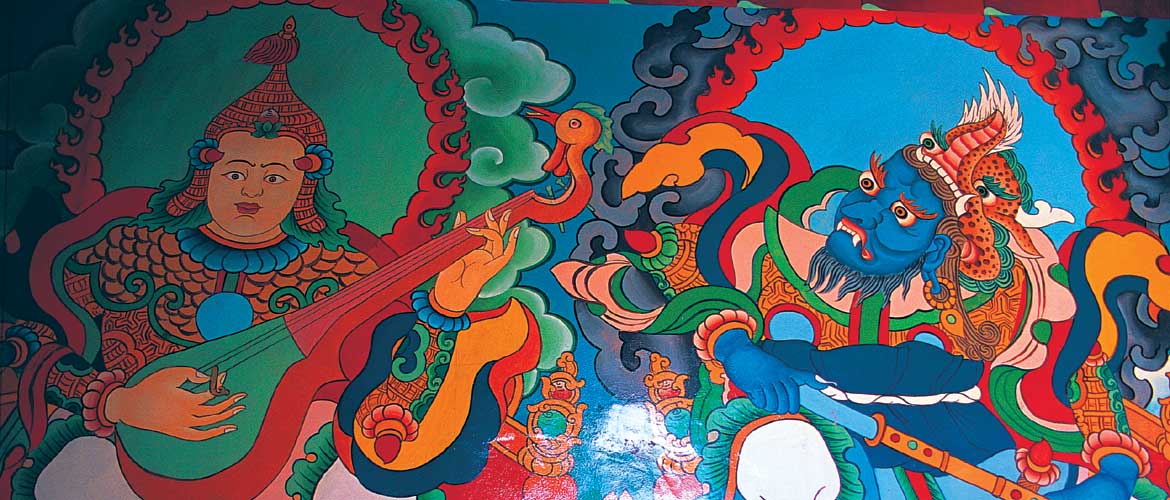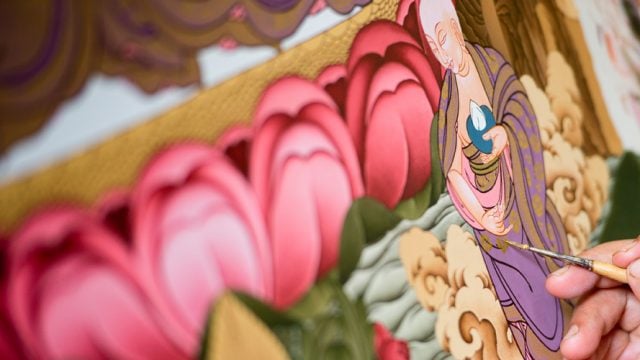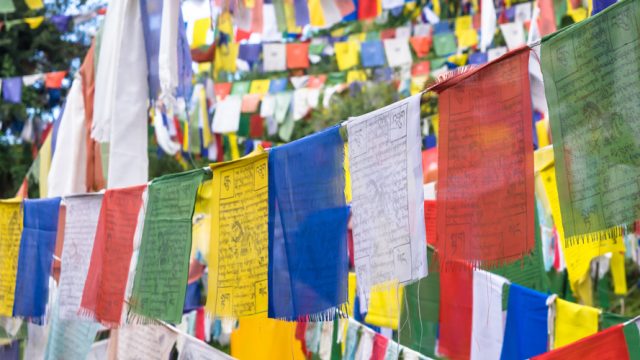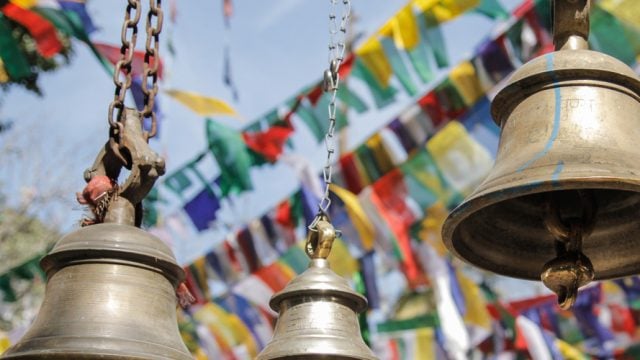The haunting cold mountain desert of Spiti, in the far northeastern corner of Himachal, is
The valley is exquisite, but requires you to give up your notions of lush green beauty. Glacial streams flow through barren, surreally coloured hills into the Spiti River, along which, on tiny oases and patches of green, small villages survive with their great monasteries. If coming from Manali, you’ll traverse Kunzum La Pass (15,059 ft), literally ‘the meeting place of ibex’, the divide between Lahaul and Spiti. You’ll find the exquisite Chandratal Lake, a glassy mirror of blue water. There are surreal blue-green- brown of the ridges and rock formations shaped by snow erosion in the valley. Villages with flat-roofed adobe houses with prayer flags fluttering from the roof tops are surrounded by a mosaic of barley and pea fields.

In the brief summer months, the villagers feverishly work in the fields. With winter temperatures as low as – 30°C, women spin and weave wool inside bukhari-heated homes and men light fires around hand pumps to melt the water. Festivals and weddings abound with much singing, eating and dancing.
Spiti’s interesting social system, still practised today, has the eldest son inheriting most of the land-holding, the eldest daughter marrying into a land-owning household and inheriting the jewel lery, and the younger siblings entering monastic orders as lamas and chomos (nuns). As it happens, this has helped keep the population of Spiti in check.
All travellers speak of the warmth of the people and the unexpected gifts of Spiti. A lama treating you to tea, hot thukpa in a village home, finding ammonites or coming aross ibex, children full of friendship and trust, the 1,000-year-old murals in Tabo monastery are some of the usual scenes you are likely to come across. Any journey would be worth such a destination.
THINGS TO SEE AND DO
Spiti’s villages can be visited by making Kaza or Tabo your base and making day trips to places around. Overnight trips are feasible since guesthouses and homestays are quite cheap. Most people practice Tibetan Buddhism and visiting the ancient monasteries will be the major part of your sightseeing.
Kaza
Kaza is the district headquarters and transport hub of Spiti. There is not much to see, but infra-structurally – with several hotels and the only petrol pump here – it is the base for exploring Spiti.

Ki (14 km NW of Kaza)
The landscape visible from the gates of Ki Monastery is stunning: blue skies, stark brown, snow-covered mountains, the Spiti River with the various shades of green of the fields. The monastery enjoys a spectacular location on a hilltop. Ki is the largest and highest (13,504 ft) monastery in Spiti and the present structure dates to the 13th century. It has a famous collection of ancient thangkas, weapons and musical instru ments. These feature during the Chham Festival in June-July.
About 11 km further up from Ki, Kibber (13,796 ft), makes for a pleasant excursion.
Langza (18 km NE of Kaza)
Langza is one of the most picturesque villages in the Spiti Valley, with the snow-capped peak of Chau Chau Khang Nilda (20,679 ft) dominating the skyline of the village. It is popular with climbing enthusiasts. The village also has a temple, said to be over a thousand years old, which houses some beautiful murals.
The Spiti region was submerged under the Tethys Sea till about 60 million years ago. The remnants of this – a variety of fossils of marine life – can be found in certain pockets of Spiti, Langza being one of them.

Dhankar (29 km SE of Kaza)
Dhankar was the erstwhile capital of Spiti, and home to the royal family before they moved to Kewling 300 years ago. Dotted with little hamlets, the drive to Dhankar village (12,762 ft) is very pleasant and you get great views of the khatpas (hoodoos – rock formations shaped, in Spiti, by snow erosion). The motor able road is an 8-km detour from the Tabo-Kaza Road. There are lovely views here, with the Dhankar Monastery and the old fort, both precariously perched on steep rock faces.
The strategic location of the fort gives panoramic views of the valley. From here you can also witness the confluence of the Spiti River with Pin, one of its main tributaries. The main attractions of the Dhankar Monastery are the brilliant wall murals depicting the life of the Buddha and the four-figured statue of the Dhyani Buddha, seated back to back.
Lhalung (30 km SE of Kaza)
Lhalung literally means the ‘land of gods’. To get here you ride for about 13 km through the awe-inspiring Lingti Valley. The wide panoramic scapes here are unparalleled.
The monastery in Lhalung is called Serkhang, the ‘golden hall’, because of the gold-leaf deities kept here. The walls are exquisitely adorned with stucco deities, mainly of Tara and Buddha. In the centre are the Maitreya Buddha, Padmasambhava and Chokche Rinpoche.
Tabo (50 km SE of Kaza)
Just 40 km from the border with Tibet, with a deceptively dull exterior, Tabo’s complex of 9 temples and cave shrines represents the oldest continuously functioning Buddhist enclave in India. But Tabo’s aura owes to more than just being over a millennium old. The vitality, refinement and serenity of artistic expression here is hypnotic.
Tabo was founded by King Yeshe Od of the Purang-Guge dynasty in West Tibet in the late 10th century CE. The king began a missionary campaign through out his realm to invigorate Tibetan Buddhism, and Tabo was set up at the crossroads of two ancient trade routes as a centre of high Buddhist learning.
The 10th-century Tsuglhakhang (the main temple) has some famous murals and wall-mounted stucco clay sculptures. Fragments from the original wall paintings can still be seen in the du khang and the ambulatory. The other prayer halls in the complex mostly date from the 15th to the 17th century.
WHERE TO STAY AND EAT
All hotels in Spiti are open mainly between mid-April and October.
In Kaza
Grand Dewachen (Tel: 01906-223301, Cell: 09459566689; Tariff: ₹8,600-9,900, with meals) offers beautiful and luxurious rooms. HPTDC’s The Spiti (Tel: 01906-222752; Tariff: ₹1,800-2,100) has rooms with attached baths and running hot water and a restaurant. Sakya Abode (Tel: 222254, Cell: 09418556213; Tariff: ₹1,320-3,150) offers 12 rooms and a decent restaurant. Their homestay Sakya House (Tel: 222213, Cell: 094182-08987; Tariff: ₹1,320) is a good option. Snow Line (Cell: 094182-08987; Tariff: ₹1,320) has 14 rooms.
You can also contact the Kaza office of the Additional Deputy Commissioner for Spiti (Tel: 01906-222301, 222252) for bookings at the New Circuit House (10 rooms; ₹ 500), Old Circuit House (5 rooms; ₹500) or the PWD Class III Rest House (3 rooms; ₹350).
Homestays
The Himalayan Homestays programme offers travellers a taste of Spiti in traditional homes set in Langza, Kaumik, Demul, Lhalung and Dhankar villages. For bookings, contact Spiti Ecosphere, Bazaar, Kaza (Cell: 09418207750, 098994-92417; email: [email protected]; W spitiecosphere.com).
In Tabo
The Tabo Monastery Guest House (Tel: 01906-223315/ 33; Tariff: ₹300-550) has 16 rooms, some with attached baths. The restaurant here is popular. Hotel Tashi Khangsar (Cell: 09418817761; Tariff: ₹700-800) has four rooms with hot water on request, and camping options for a small fee. Tiger’s Den (Cell: 09418817761; Tariff: ₹800-1200) has ten rooms and a restaurant. Dewachen Retreats (Tel: 01906-223301, Cell: 09459566689; Tariff: ₹4,500-7,000 with meals) has nine rooms. Donkhang Homestay (Cell: 09418984345; Tariff: ₹250-300), next to the old monastery, is a clean place with two rooms. For food try Monastery Restaurant, Taslin Khangsar, Amit Restaurant or the German Bakery.
When to go June to Oct. Road from Manali is open only between mid-June and mid-Oct. The road from Shimla is treacherous in monsoon (July-Aug) Location Spiti is a mountain-desert region in north-eastern Himachal, on the Tibet border Air Nearest airport: Bhuntar, Kullu Rail Nearest railheads: Kalka and Chandigarh
|
THE INFORMATION |
|
Tourist/ Wildlife Offices Himachal Tourism Near Victory Tunnel, Shimla Tel: 0177-2654589 W hptdc.nic.in, W himachaltourism.gov.in |
|
HPTDC The Mall, Shimla Tel: 0177-2652561, 2658302 |
|
HPTDC 36, Chandralok Building Janpath, New Delhi Tel: 011-23325320/ 4764 Naggar |
|
HPTDC Hotel Castle, Naggar. Tel: 01902-248316 STD code 01902 Shoja |
|
HPTDC Dhalpur, Kullu. Tel: 01902-222349 |
|
Himachal Tourism Tourist Information Centre Dhalpur, Kullu. Tel: 224605 STD code 01903 Rewalsar Lake |
|
HPTDC Tourist Inn, Rewalsar Tel: 01905-240252 STD code 01905 Tirthan Valley |
|
Director, GHNP, Shamshi Kullu. Tel: 01902-265320 |
|
Himalayan Ecotourism Gushaini, Tehsil Banjar Kullu. Cell: 09816091093 STD code 01902 |
|
THE INFORMATION |
|
Kasol & Manikaran HPTDC Dhalpur, Kullu Tel: 01902-222349 STD code 01902 Spiti |
|
HPTDC The Spiti, near Government Hospital Kaza; Tel: 01906-222752 |
|
Himachal Tourism Tourist Office, The Mall, Manali Tel: 01902-252175 |
|
Himachal Tourism Rekong Peo Tel: 01786-222897 STD code 01906 |
|
TIP Foreigners need an Inner Line Permit, from the District Collectorate office in Shimla |
Chandratal Lake
Dhankar
Dhankar Monastery





